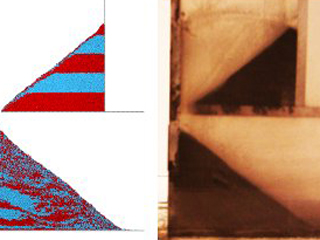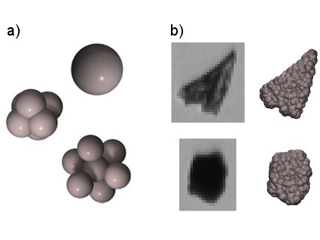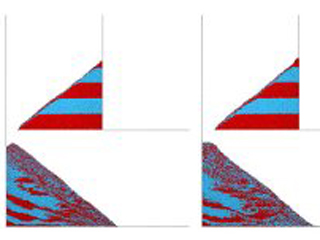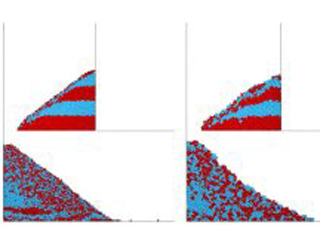Granular materials
Options

Granular materials represent an obvious range of applications for particle-based simulation. Compared with continuum mechanics methods, the particle-based approach allows materials to be analyzed at particle level. Physical phenomena such as friction and cohesion can be modeled directly. The form and size distribution of the particles are also handled realistically. One great advantage of simulation over experimentation is that particle properties can be varied independently of each other in order to investigate their effect on the overall process.
The various industrial applications of granular materials differ depending on their specific geometry and the process management. In order to do justice to these aspects, any geometry components, e.g. silos, hoppers, pipes and conveying systems, can be included in the SimPARTIX® simulation. The interaction between the particles and the walls (e.g. friction) is adjusted to suit the respective material. Moving components can be included in the modeling either kinematically or dynamically, i.e. either the motion of the parts is prescribed without considering reactive forces due to the granular material, or the reactive forces are included directly in the calculation of the motion.
One strength of the particle-based approach is to be found in the evaluation of the simulations. Every particle can be output individually. In the static state it is possible to determine density, stress conditions, the degree of segregation and particle orientations, for example. In dynamic situations flow rates or spatially resolved velocity distributions can be added to these parameters. Credible process graphics can be produced for advertising or teaching purposes.
Examples: die filling, powder compaction
Particle shape

The shapes of individual particles in industrial applications can be very simple, but also as complex as you like. Concrete examples of particle forms that occur are spheres, elongated or oblate ellipsoids (e.g. tablets), angular or linear particles, also irregular or dendritic particle surfaces. The modeling makes use of spheres as standard geometrical objects. Therefore, some of the aforementioned shapes are easy to emulate, whereas others require a considerable input.
Many publications show that, for example, flow profiles and stress distributions in silos can be modeled well with sphere-based models, even if the actual material itself has a more complicated form. On the other hand, the angle of repose of a pile of irregularly shaped grains can only be reproduced when the model particles can also interlock with and hence support each other.
A rough approximation of the true particle form is often sufficient for reproducing many properties of a granular material in the simulation. Generating the form of the model particles can in this case usually be carried out automatically by adapting key parameters such as the aspect ratio or the sphericity. If, however, the exact degree of filling of a volume is to be determined, for example, then it will be necessary to model the true particle geometry as faithfully as possible (see figure).
Coarse graining


Granular systems with extremely large numbers of particles (i.e. more than about 10 million) cannot yet be simulated because of the computing capacity required. In such situations, however, it is often possible to use so-called coarse graining. Here, a multitude of small particles is replaced by a smaller number of larger particles. However, adapting the interaction laws ensures that the macroscopic behavior of the granular material remains unchanged (see figure). Target variables such as flow profiles, density distributions or stress states, for example, can then be determined with the coarser material model.
The upper limit for the artificial enlargement of the particles is when the particle size reaches the range of the dimensions of the enclosing geometry. Coarse graining is only unacceptable as a principle when the material properties are directly dependent on the particle size. Appropriate simulations can be used to determine whether this is the case.
 Fraunhofer Institute for Mechanics of Materials IWM
Fraunhofer Institute for Mechanics of Materials IWM